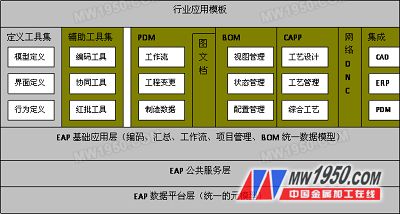1. CAXA collaborative management overall plan
1.1 Product Positioning
The CAXA Collaborative Management Solution is an enterprise-level solution for the lifecycle management of manufacturing product data. This solution is an extension and deepening of CAXA graph document solution application, focusing on the departments that enterprises face after deepening information management applications. Collaboration and application requirements for global sharing of enterprise product data enable unified management of enterprise design data, process data and manufacturing data, and support enterprise data processing and business collaboration across departments.
In the data model construction, the CAXA collaborative management solution adopts a unified data element model to ensure data consistency and avoid information islands. In the application model construction, the CAXA Enterprise Application Platform (CAXA Enterprise Application Platform, CAXA EAP) is used for design. To ensure the consistency of application transactions and avoid data confusion; in the business logic construction, the data built-in behavior and application behavior definition are adopted to ensure the free combination of services and avoid process rigidity. The scalability and flexibility of CAXA EAP makes the CAXA collaborative management solution highly open.
CAXA collaborative management solution can not only be used as an upgrade and extension of CAXA graph document application, but also form an enterprise-level management platform. It can also be used as an independent application development platform to provide third-party extended application development on this basis.
1.2 plan configuration diagram
The CAXA collaborative management solution is based on CAXA EAP. Based on this platform, CAXA diagram documents, network DNC, BOM and other products are constructed. These products use the model definition tools provided by EAP to build a unified data model. The application interface is provided by EAP. The application design tool defines a consistent user interface; the management process can implement consistent process management using the process definition tools provided by EAP.
CAXA EAP adopts the SOA design idea to realize the modularization of the underlying components and application components. These modules support the standard WEB service interface and have the ability to further construct data processing and logic processing on the INTERNET.
The CAXA collaborative management solution application deployment diagram is as follows:

Figure CAXA Collaborative Management Application Deployment
The data platform layer, the common service layer and the basic application layer belong to the EAP content, which is the support layer of the application, and is an indispensable operating environment for the CAXA collaborative management solution application; the definition tool set is a definition tool of the CAXA platform configuration, and implements the model and Graphical definition of the application.
At the application level, PDM, diagram documents, BOM, CAPP, etc. are products or solutions that can be sold independently.
Coding tools, collaboration tools, and red batch tools in the tool set are tools that can be used to sell products.
Industry application templates are industry applications based on platforms and application systems, including industry data models, industry application extensions (such as the TS16949 support for the automotive industry), and industry practices (such as the basic-based variant design application model for the motor industry). Wait.
1.3 Solution Features
The CAXA collaborative management solution has the following characteristics:
1. The solution is based on CAXA EAP, an autonomous, powerful and flexible basic platform. The data model is unified and the application style is consistent;
2. Undertake all the data from the CAXA diagram document solution based on the unified platform development definition to ensure a smooth transition of the application;
3. Flexible expansion, convenient customization, short deployment period, and effective integration and docking with third-party application software.
| Previous page | 1 | 2 | 3 | 4 | 5 | 6 | 7 | Next page |
Cold Rolled Stainless Steel Sheets
Stainless steel plate surface smooth, high plasticity, toughness and mechanical strength, acid, alkaline gas, solution and other media corrosion resistance. It is an alloy steel that does not rust easily, but not absolutely. Stainless steel plate refers to the corrosion resistance of weak medium such as atmosphere, steam and water steel plate, and acid resistant steel plate refers to the corrosion resistance of chemical etched medium such as acid, alkali, salt steel plate.
According to the structure is divided into austenitic stainless steel plate, martensitic stainless steel plate (including precipitation hardening stainless steel plate), ferritic stainless steel plate, and austenitic ferritic biphase stainless steel plate and so on four categories? According to the main chemical composition of the steel plate or some characteristic elements in the steel plate to be classified into chromium stainless steel plate, chromium nickel stainless steel plate, chromium nickel molybdenum stainless steel plate and low carbon stainless steel plate, high molybdenum stainless steel plate, high purity stainless steel plate. According to the performance characteristics and use of steel plate classification, is divided into nitric acid resistant stainless steel plate, sulfuric acid resistant stainless steel plate, pitting stainless steel plate, stress corrosion resistant stainless steel plate, high strength stainless steel plate. According to the functional characteristics of the steel plate, it is divided into low temperature stainless steel plate, no magnetic stainless steel plate, easy cutting stainless steel plate, super plastic stainless steel plate. Currently, the commonly used classification method is according to the structural characteristics of steel plate and steel plate chemical composition characteristics and the combination of the two methods. Generally divided into martensitic stainless steel plate, ferritic stainless steel plate, austenitic stainless steel plate, duplex stainless steel plate and precipitation hardening type stainless steel plate or divided into chromium stainless steel plate and nickel stainless steel plate two categories.
Typical uses: pulp and paper equipment heat exchanger, mechanical equipment, dyeing equipment, film washing equipment, pipelines, coastal area building external materials, etc.
Cold Rolled Stainless Steel Sheets,Stainless Steel Sheet,Stainless Steel Coils,Astm Stainless Steel Sheet
Shandong Xinsuju Steel Co.,Ltd. , https://www.sawlpipe.com
